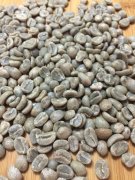The New World characteristics and Origin Story of the 11 most Common Coffee Bean varieties
Whether true or not, it is undeniable that most coffee beans do come from Ethiopia, Sudan and Yemen. After most coffee beans leave the origin, genetic mutations occur under natural conditions or artificial hybridization. You may have heard of Ethiopia's native species, rose summer, but there are more than 100 kinds of coffee beans in the world. Of course, it is impossible to include all the beans in a short article, but you can explain in detail the 11 most common coffee beans on the market and their origin and characteristics.
Iron Pickup (Typica)
This is a natural variant native to Yemen. It is now the most common bean variety in the world because the Dutch grew it in Indonesia, the French brought it to the Caribbean, and later spread throughout Central and South America. Tiekka coffee yields are small and is highly susceptible to rust leaf disease, so most plantations do not grow tiekka coffee alone. Unlike other bean varieties, the fruit of Tiekka coffee is conical. The high quality of Tiekka coffee makes it very popular with plantations around the world. When grown properly, Tiekka coffee is sweet, pure in taste and pleasant in acidity.
Bourbon
Like iron pickup, bourbon is a natural variety native to Yemen. Its name comes from its original cultivation on Bourbon Island, which is now Reunion Island. During the French colonial period, the French often exported this coffee overseas, especially to the United States. Bourbon coffee fruits are short, round and have a high density of pulp and seeds. Bourbon coffee is usually high in sweetness and bright in acidity. The yield of this coffee is 20-30% higher than that of iron pickup, but it is still considered a low-yield bean and is also susceptible to leaf rust. Most bourbon coffee fruits are red, but two natural varieties appear in different colors, orange bourbon and yellow bourbon. Orange bourbon is sweeter, while yellow bourbon is more acidic.
Caturra
The Bourbon and Iron Pickup bean varieties have spawned many natural mutations and artificial hybrids, and Katula is one of them. Catura is a natural variety of bourbon coffee originally discovered in Brazil. Katula coffee is most common in Central America, where the coffee plant is shorter, easier to pick, and has higher yields than bourbon. But it is precisely because of this that castura coffee tastes thinner than bourbon and is relatively less sweet, but it has a bright sour taste, pure taste and pleasant acidity.
The Elephant Bean (Maragogype)
Elephant beans are a variety of iron pickup coffee, large in size but lower in yield. After baking, the elephant bean reminder is two cups of regular bourbon and most iron pickup variants. You might think that the bigger the beans, the richer the flavor, but this is not the case. Although the taste of elephant beans is more mellow, it lacks complexity and is often used to make Italian concentrated blends to increase overall complexity.
The New World (Mundo Novo)
New World is a natural hybrid of red bourbon and Sumatra iron pickup, especially popular in Brazil and other places, accounting for 40% of Brazil's Arabica coffee cultivation. New World has a high yield, 30-40% higher than regular bourbon coffee, and is highly resistant to disease. Generally, New World coffee is less sweet due to its higher yield per plant.
Catuai
Kaduai is a hybrid of new world and kathura. If grown properly, the sweetness is high. Kaduai is known for its strong adaptability and ability to grow in stormy areas, so it is considered one of the safest bean seeds.
Catimor
Katim is a hybrid of Tim (a natural variant of Robusta) and Katura, produced in laboratories in Portugal. Katim has excellent disease resistance and adaptability, high yield, easy care, and unique taste, with sharp acidity, sometimes with a little astringency. Katim is arguably one of the most successful examples of laboratory breeding.
Castillo
Castillo is another laboratory-grown bean seed that is arguably more successful than Katimo. Tracing its origins, Castillo is a result of long cultivation and artificial mutation and interbreeding of Katimo coffee. Cenicafe, the National Coffee Research Center in Colombia, has long been working to find beans with high disease resistance and adaptability. Although Castillo coffee tastes slightly worse, the quality of Castillo coffee is improving as more farmers grow it in Colombia and the cultivation and green bean processing techniques continue to improve.
Pacamara
Born at the Salvadoran Coffee Research Center, pacamara is a hybrid of elephant beans and pacas, a natural variety of bourbon. Its appearance resembles a bean, but it tastes floral, sweet and pleasant acidity.
SL28 and SL34
Scott Labs collaborated on Kenyan coffee and local production in the 1930s and 1960s, resulting in two artificial hybrids of bourbon and Ethiopian heirloom coffee. The yield of SL34 was slightly higher than that of SL28. The two bean varieties were average in disease resistance, but taste was the key to their cultivation. Today, two types of coffee are Kenya's main coffee beans, producing 90% of Kenya's total coffee exports. Both coffees are sweet, aromatic and rich in flavor.
Gesha
Perhaps one of the hottest bean varieties today, rose summer is a variant of ethiopian heirloom coffee. This coffee was first discovered in Guixia (or Abyssinia) and is highly prized because of its low yield. Many farmers have tried to cross it with high-yield beans, with great success in Central America and Panama. Among them, Panama's La Hacienda Esmeralda plantation is known for producing the best quality and highest price coffee in the world. Their coffee has won the "Best Coffee in Panama" award, with extremely unique bergamot, jasmine and peach aromas.

Important Notice :
前街咖啡 FrontStreet Coffee has moved to new addredd:
FrontStreet Coffee Address: 315,Donghua East Road,GuangZhou
Tel:020 38364473
- Prev

The flavor of Ecuadorian boutique coffee introduces the drinking method of Ecuador
Ecuadorian raw beans are mainly treated with water washing, and the taste of raw beans is mixed with a little wheat flavor. On the surface, the silver skin is more emerald green and yellow. After baking, Ecuador has a rich taste, and people like it in the mouth. A mellow sweet taste of honey lasts for a long time. Hand cooking is recommended.
- Next

The different faces of coffee beans have long been changing personalities
Professional barista communication, please pay attention to coffee workshop (Weixin Official Accounts cafe_style) long-term placement of more than two or three bags of different varieties of coffee beans in the home, if added to the company, the total number should be maintained at about five or six bags. With a packet of about 200g, each cup of coffee with 20g beans, such an amount of more than two months to complete, and then look at the best coffee beans is actually
Related
- Guji coffee producing area of Guji, Ethiopia: Humbela, Shakiso, Wulaga
- What is the most expensive variety of Qiloso in BOP multi-variety group?
- How to store the coffee beans bought home?
- Why are Yemeni coffee beans so rare now?
- Ethiopian Sidamo all Red Fruit Sun Sun Santa Vini Coffee beans
- SOE is mostly sour? What does it mean? Is it a single bean? what's the difference between it and Italian blending?
- Is Italian coffee beans suitable for making hand-brewed coffee?
- How to choose coffee beans when making cold coffee? What kind of coffee beans are suitable for making cold coffee?
- Just entered the pit to make coffee, what kind of coffee beans should be chosen?
- Can only Japan buy real Blue Mountain Coffee? What are authentic Jamaican Blue Mountain coffee beans?

